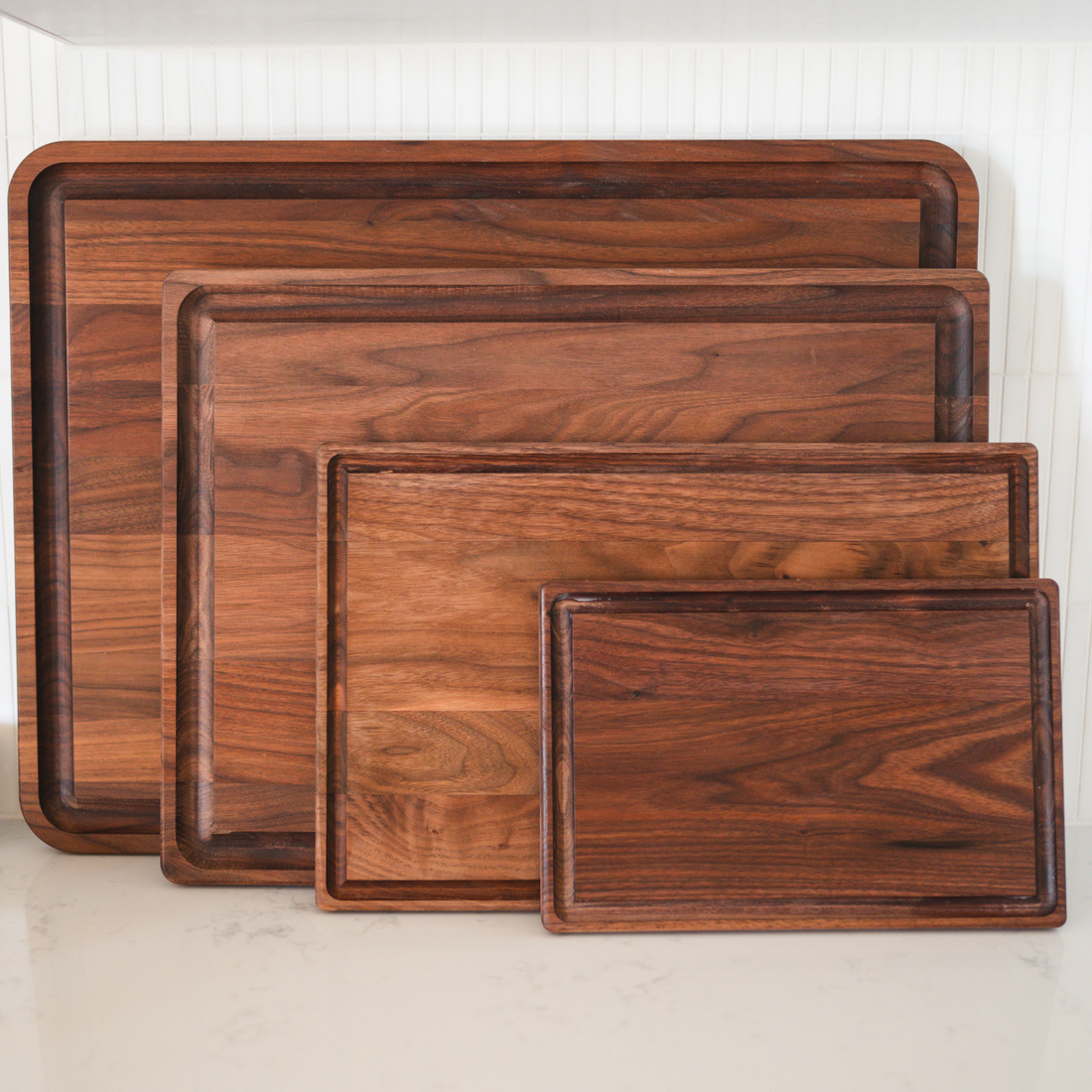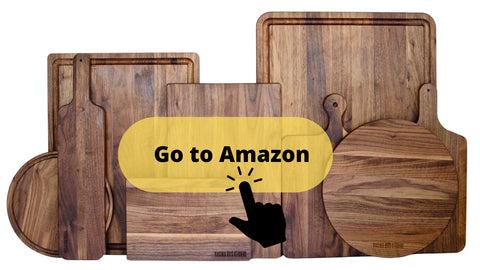What's the Typical Cutting Board Size?
In the variety of kitchen tools, cutting boards play a significant role. The size of the cutting board has a profound impact on its functionality and usability in the kitchen. While there are The typical size boards vary depending on the needs and requirements of each individual.
By far, the most versatile and most common size that every kitchen should have is the 17"x11" or 18"x12". With these, you can then add additional boards based on what you need.
Does the Cutting Board Size Matter?

So, does the size of the cutting board matter? The answer is a resounding yes. The size of the board you chose can significantly affect your culinary experience. Large boards can provide ample space for cutting and chopping multiple ingredients simultaneously. They are particularly beneficial when preparing meals for a large group or family.
On the other hand, small boards are lightweight, easy to handle, and perfect for quick tasks like slicing fruits or cheese. Therefore, the size of the cutting board matters as it directly impacts its utility and functionality in the kitchen. It's crucial to choose a size that best suits your cooking style and kitchen space.
Common Sizes of Cutting Boards
The common cutting board sizes range from small to extra large, each serving a specific purpose in the kitchen. These sizes are typically classified by their length and width measurements. Let’s talk about 4 common sizes you might find:
8” X 12” Cutting Boards (Small)
The 8” X 12” cutting board is a popular choice among many home cooks. This size is compact, making it ideal for small kitchen spaces. It is perfect for performing simple tasks such as cutting fruits, vegetables, or cheese. Despite its small size, it offers sufficient space for most culinary tasks.
It's lightweight and easy to manage. Its small size also makes it easy to store, making it a favorite among those with limited kitchen space. It also fits nicely in most kitchen drawers.
17” X 11” Cutting Boards (Medium)
For those who frequently cook or have larger kitchen spaces, a 17” X 11” cutting board might be more suitable. This size is larger than the 8” X 12” and provides more room for chopping and slicing.
It is an ideal size as it fits into most kitchen spaces, and is big enough for most kitchen jobs. Think larger fruit and vegetable items such as canteloupes and squashes. Also a great surface to season steaks, make burger patties from ground beef, etc...
Although it's slightly heavier than the smaller boards, it's still manageable and easy to use. It is also a great size as a serving board - such as charcuterie for 2-4 people.
20” X 15” Cutting Boards (Large)
A popular choice for many cooks is the 20” X 15” cutting board. This size is large enough to handle a variety of tasks, from slicing large roasts to chopping an array of vegetables, and batch food prepping.
A board this size has ample space for all your food prep needs. You can slice and cut, push it to a side, and repeat. It is ideal for preparing meals for a larger family.
As a carving board, it also features a juice groove, so go ahead and slice those briskets and roasts on it.
This 20x15 walnut cutting board is a good fit for those who often prepare large meals or enjoy tackling ambitious culinary projects. However, those with limited counter space might find it a bit too large for comfort.
You'll need to store this cutting board up against the kitchen counter. Thankfully in its horizontal position, it will be fine for most kitchens, you will probably have enough room between the counter and the bottom of your cabinets.
18” x 24” Cutting Boards (Extra Large)

If the typical cutting board sizes don't quite meet your needs, you might consider an 18” X 24” cutting board. This extra-large size is perfect for those who frequently cook for large groups or need a lot of space for their culinary creations.
This board offers a generous workspace and also comes with a juice groove to contain any liquid from your food.
This board is heavy, and it's big. The most common reason we at Virgnia Boys Kitchens get returns for this board is "I didn't know it was going to be this big", or "it's too big for my kitchen". So it's BIG.
However, f you cook a lot and have the kitchen space for it, you'll love having it around. I find it extremely convenient for food prep - I can chop, cut, push aside, chop, cut, push aside several times before running out of room.

This board is also perfect for turkeys, larger roasts, and briskets. You might only need it a few times a year, but when you need it, you'll be thankful it's there!
Cutting Board Thickness
Cutting board thickness is another crucial factor to consider. The thickness of a cutting board can impact its stability and durability. Typically, cutting boards range in thickness from 0.75” to 3”.
The most common thickness is 0.75", which provides a good balance between stability and ease of handling. However, boards used for heavy-duty tasks, such as butchering meat or serving charcuterie boards, may need to be thicker for added durability. In these cases, you might be better off with "end grain" cutting boards - they are much thicker and looks awesome, too!

On the other hand, thicker boards like “butcher blocks” or “end grains” are usually between 1.5” to 3”. These substantial boards are perfect for heavy-duty tasks and also make a dramatic statement in your kitchen. However, they can be heavy and may require more effort to clean and maintain.
Also, consider the fact that it adds that many inches in height to your kitchen counter. Shorter men and women might find it uncomfortable to work at this added height.
Which Size Should You Buy?
The size of the cutting board you should buy largely depends on your cooking needs and kitchen space. I would start with the most common size, which is the 17” X 11”, with a standard thickness of 0.75".

Then, base on your additional needs, pick out a second board. We don't call this the "everyday board" for no reason!
Regardless of the size you choose, it's always beneficial to have at least two to three different sizes on hand. This allows you to use the right size board for each task, helping to make your food preparation more efficient and enjoyable.
Factors to Consider When Selecting a Cutting Board Size
When selecting a cutting board size, there are several key factors to consider:
Counter Space
One critical factor to consider when selecting a cutting board size is the counter space available in your kitchen. If you're working with a smaller countertop, a large cutting board may not be the best choice. In contrast, if you have a spacious kitchen with ample counter space, investing in a bigger cutting board can be a viable option. It's important to ensure that your cutting board fits comfortably on your counter without hindering your cooking process.
Weight
Another essential factor to consider is the weight of the cutting board. A heavier board can provide stability during use, but it may also be challenging to move around. It's important to note that the thickness of the cutting board can add to its weight and height. This can make it difficult for shorter individuals to comfortably prepare food, especially if the board is placed on a standard kitchen counter. Therefore, those who are shorter in height should consider these factors when choosing a cutting board.
Storage Space

Storage space is another key consideration when selecting a cutting board. The size of your cutting board should align with the storage options available in your kitchen. Larger cutting boards require more storage space, which may not be feasible in a kitchen with limited cabinet or counter space. The goal is to choose a board that doesn't clutter your kitchen but fits neatly when not in use.
Ease of Cleaning

The ease of cleaning is an aspect that cannot be overlooked when choosing a cutting board. A larger cutting board may be more challenging to clean due to its size and weight. It's advisable to hand-wash your cutting board with soapy water and ensure it's thoroughly dried to prevent bacterial growth. The cleaning process should be manageable and not turn into a cumbersome task.
How big is your kitchen sink? Do you have a pull-out faucet?
Final Thoughts

As one explores the various aspects of cutting boards, it becomes evident that the size of the board is a significant factor. A cutting board is a quintessential kitchen item, vital for everyday tasks like chopping, mincing, dicing, and smashing. Just as a chef needs their skills, they also require a sturdy board to execute these tasks properly.
However, the best cutting board size is not a one-size-fits-all answer. It's not merely about picking the board, but rather considering what would work best for your unique kitchen and cooking needs.
Related Products You Might Like:
8" x 12" x 0.75" - small cutting board
17" x 11" x 0.75" - medium cutting board
20" x 15" x 1" - large cutting board
18" x 24" x 1" - extra large cutting board
We are also on Amazon:
We are on Amazon, see our storefront here. Use coupon code VBKBLOG10 for 10% off your entire purchase of any Virginia Boys Kitchens on Amazon. Apply the code at checkout.






